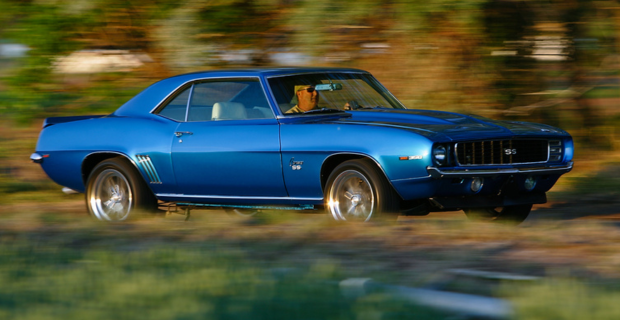Date Published: 2024/03/07
Read Time: mins
Classic car of the month: The debut of the Chevrolet Camaro Pony Car in 1966

Imagine this: It’s the mid-1960s, and Ford has the sports car market cornered with its wildly popular Mustang. How could their competitor knock them off their pedestal? With the release of their iconic pony car, the Chevrolet Camaro. Although this car hit the streets in 1966, its 1967 badging welcomed the new year in style. With this move, Chevy gave the world an endlessly coveted sports car and sparked one of the greatest rivalries in automotive history.
Say Hello to Chevy’s First Pony Car
Sporty, compact, and oh-so-stylish, the pony car was the industry’s response to the land yachts of yesteryear. By cleverly pairing practicality with fun, these cars were like a breath of fresh air. People could finally escape large, heavy, and often unwieldy vehicles to enjoy a more thrilling driving experience.
The 1966 Chevrolet Camaro was the perfect example of this new trend. As Chevy’s first pony car, it perfectly blended agility, performance, and style in a small package. Drivers could enjoy the best of both worlds: the ease and efficiency of a compact car with the heart and soul of a high-performance automobile.
The Camaro’s Head-Turning Style
The first-generation Camaro was a head-turner from the very start. Built on the all-new F-body chassis, this car features a long, sleek hood and a short rear deck. The low, wide stance completed the sporty, muscular look, hinting at the power under the hood. The base configuration had two doors, a 2+2 seat setup, and a hardtop, but buyers could also get theirs as a convertible. Beyond that, buyers chose between the RS, SS, and Z/28 packages. As the main appearance package, the RS changed its styling the most, adding hidden headlights, revising taillights, and adding bright trim for the exterior. The SS performance package didn’t just upgrade its power; it beefed up the hood with air inlets and added special striping. The Z/28 went even further by plastering the hood with two notable skunk stripes from nose to tail.
V8 Powerplants for Pure Performance
The first-gen Camaro was so much more than a feast for the eyes with its stunningly good looks. Beneath its sleek exterior, beat the heart of this high-performance beast: its V8 powerplants.
The 140-horsepower inline six-cylinder engine carried most of these models from the showroom to the streets. And you’d be right. However, this was just the beginning of Camaro’s performance story.
A game changer was the release of the Z/28 model with its 4.9L V8 powerplant. This package boosted this model’s competitiveness in the SCCA Trans-Am Series when paired with additional mods. For those seeking even more power, there was the SS performance package. Models equipped with this package got a big boost in power, whether equipped with the 5.7L V8 or 6.5L V8 powerplant.
But for the true enthusiasts, the real excitement lay in the Chevy’s Central Office Production Orders (COPO) system. This special-order process allowed well-connected buyers to create their unique powerhouses. This led to the creation of the COPO 9561, featuring the 425-horsepower L72 big block engine. Following that special order was the even more exclusive COPO 9560, with its 430-horsepower ZL-1 engine. Very few people got their hands on these first-gen COPO Camaros, though. Chevrolet only made 1,000 COPO 9561s and a mere 69 of the COPO 9560s. Today, spotting one of these is akin to seeing a unicorn. It’s a rare and exciting glimpse into a unique chapter of automotive history.
A Peek Inside the 1966 Camaro
The interior of the Camaro was just as impressive as its exterior styling and powerplant options. The interior was designed with the driver in mind, as with the rest of the car. Cosy bucket seats made for a comfortable ride yet offered enough support for spirited driving excursions. The floor shifter sat nearby within the centre console, keeping complete control at the driver’s fingertips. The dashboard featured oversized gauges to make monitoring the car’s health and performance easy.
What truly set the interior apart was the colour-matched design scheme. Everything, from the seats and carpet to the dash and door panels, came in the same vivid hue, perfectly complementing the exterior paint. This attention to detail gave the interior a luxury and refinement that could rival even modern cars today.
Relive Your Glory Days in Safety and Style
If you’re lucky enough to own a first-gen Chevy Camaro, it’s important to ensure that your vehicle is well protected. Fortunately, it’s easy to get the right level of protection with tailored collector car insurance options. You can go with basic coverage or upgrade with add-ons like Vehicle Under Construction Endorsement and roadside service. It’s how to enjoy true peace of mind whether you’re on the road or just storing your car for the winter.
Sources
https://www.grangerchevrolet.com/blog/chevy-camaro-history/
https://automotivehistory.org/august-11-1966-the-first-production-chevrolet-camaro-is-born/